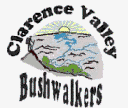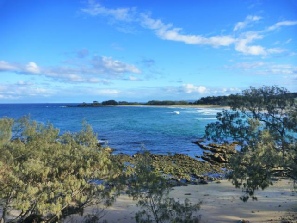

Yaraygir National Park

Vegetation
Rainforests
At Red Cliff, Sandon and Diggers Camp you'll find coastal (littoral) rainforest dominated by tuckeroo (Cupaniopsis anacardioides) and rusty fig (Ficus rubiginosa).
Dry eucalypt forests
Dry eucalypt forest can be found at Illaroo, Pebbly Beach and Station Creek. Species include:
* blackbutt (Eucalyptus pilularis)
* smooth-
* red bloodwood (E. gummifera)
* tallowwood (E. microcorys)
* scribbly gum (E. signata)
* pink bloodwood (E. intermedia).
Heathlands
Dry or sand heath is dominated by Banksia aemula while clay heathland is dominated by Banksia oblongifolia. Wet heathland is found on drainage depressions or poorly drained river flats and can have many species including Xanthorrhoea fulva. See examples of heathland at Shelley Track, Diggers Camp and Boorkoom.
Freshwater wetlands
This plant community is dominated by:
* swamp mahogany (Eucalyptus robusta)
* paperbarks (Melaleuca sieberi and M. nodosa)
* swamp oak (Casuarina glauca).
You'll find examples at Lake Arragan and Sandon.
Native Animals
Mammals
Thirty mammal species have been recorded in the area, and common species include:
* grey kangaroo (Macropus giganteus)
* red-
* brush-
* sugar glider (Petaurus breviceps).
The heathlands provide habitat for many small mammals, including:
* grassland melomys (Melomys burtoni)
* New Holland mouse (Pseudomys novaeholliandiae)
* bush rat (Rattus fuscipes).
Mammals listed as threatened found in Yuraygir include:
* rufous bettong (Aepyprymnus rufescens)
* spotted-
* brush-
* squirrel glider (Petaurus norfolcensis).
Fourteen bat species have been recorded at Yuraygir, including rare species such as the Queensland blossom bat (Syconycteris australis) and the hoary wattled bat (Chalinolobus nigrogriseus).
The spotted-
The squirrel glider (Petaurus norfolcensis) is very similar in appearance to the
much more common sugar glider but is twice as large with a long bushy tail and distinct
facial markings. Their favoured habitat in coastal areas is eucalypt forest with
a heath understorey. They need hollows for nesting and at least one species of winter-
Birds.
The flowering heathland areas support many nectar eating birds, with late winter to early spring considered a prime time for observation.
Wet heathlands and swamp edges are favoured habitat for two threatened species: the
ground parrot (Pezoporus wallicus) and the eastern grass owl (Tyto longimembris).
The brolga (Grus rubicundus) and the black-
Both the pied oystercatcher (Haematopus longirostris) and the sooty oystercatcher (Haematopus fulginosus) are seen on rock platforms and intertidal areas. The mongolian plover (Charadrius mongolus) black bittern (Dupetor flavicollis) and the osprey (Pandion halietus) can also be seen in estuarine areas of the park.
The glossy-
Other interesting birds include the rare masked booby (Sula dactylatra), recorded
in the waters beside Yuraygir, the little tern (Sterna albifrons) which nests on
beaches within the park, and the red-
The little tern (Sterna albifrons) migrates from eastern Asia, arriving here each summer. They are mainly seen from September to April. Their favoured habitat is coastal waters, shallow inlets and salt or brackish lakes. Their nests are very vulnerable to disturbance as they consist of a scrape in the sand, into which two or three speckled eggs are laid. This means that humans, vehicles, feral animals and domestic dogs and cats can easily damage their nesting areas. Some known breeding areas have been fenced off by the National Parks and Wildlife Service.
The Yuraygir Coastal Walk track marker includes the footprint of the endangered coastal emu (Dromalus novaehollandiiae) as a guide. The total number of emus in Yuraygir National Park is less than 100. Once in abundance, the local population has been in steady decline over the past 20 years as a result of habitat loss, fires during the spring breeding season, predation by foxes and wild dogs, and collisions with vehicles. The coastal emu has recently been listed as an endangered population.
Amphibians and Reptiles
Interesting reptiles found at Yuraygir include the diamond python (Morelia spilota)
and the bearded dragon (Amphiloborus barbatus). There are about 36 species of reptiles
in the park, including venomous species such as the common death adder (Acanthophis
antarcticus) and the rough-
Of the 25 amphibians found at Yuraygir, common species include the rocket frog (Litoria nasuta) and the eastern dwarf tree frog (Litoria fallax). Threatened frog species include the green and golden bell frog (Litoria fallax) and the wallum froglet (Crinia tinnula).
Green and golden bell frogs are large colourful frogs found around swamps, lagoons and flood plains. Once widespread, they are now found only at isolated locations. The main threats to their survival are drainage of wetlands, poor water quality, predation of tadpoles and eggs by introduced fish, use of chemicals near wetlands and the chytrid fungus.
Invertebrates
There's a diverse array of invertebrate life at Yuraygir, but little is recorded of the species present.
© State of New South Wales through the Office of Environment and Heritage
Click on the link for more information about Yaraygir National Park
Positioned on the NSW north coast between Yamba and Coffs Harbour, Yuraygir National Park boasts the state’s longest stretch of undeveloped coastline. With 65km of striking cliffs, rocky headlands, isolated beaches and quiet lakes set against a backdrop of forests, heaths and wetlands, this colossal park is a place to experience, not just see.
Discover rare wildlife, remote campgrounds, idyllic picnic spots and charming villages
dotted along the coast. Swim, fish or surf to your heart’s content in this aquatic
playground. Go whale watching or try the multi-